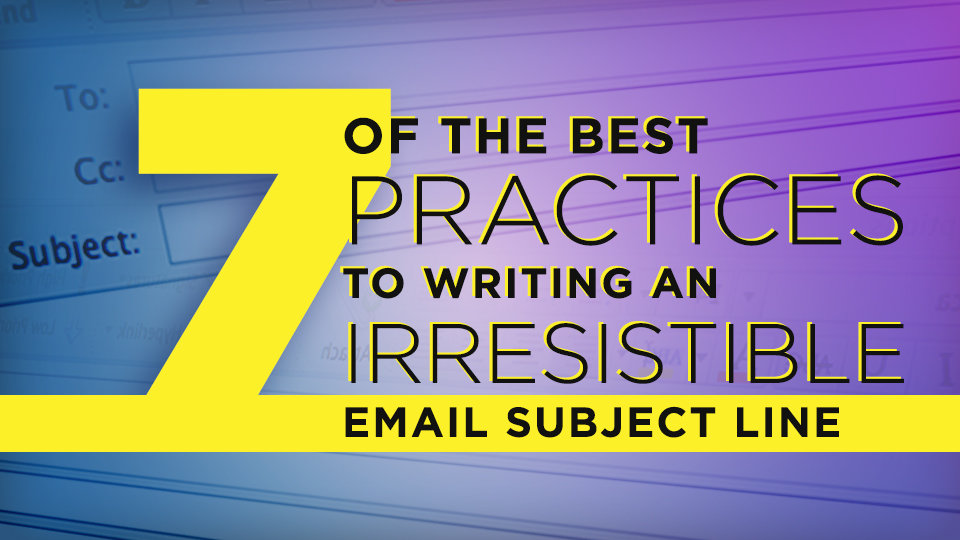7 Tips That Will Help You Write an Irresistible Email Subject Line
By The A Group
“You never get a second chance to make a good first impression.” These words spoken by Will Rogers couldn’t be truer when it comes to writing an irresistible email subject line.
You are in a heated competition for people’s attention. Everyday people are scrolling through their inbox, reading text messages, and commenting on their friend’s social media status while watching a video on YouTube. The sea of information we swim through on a daily basis is mind-boggling. This is why it’s vitally important to write an eye-catching email subject line to help you cut through the noise your email recipients are living in.
Your email subject line is the bait by which you lure in your email recipients. It will determine whether or not your email is marked as spam, opened, or even read. If your email subject line does not catch your readers’ eyes or whet their appetite for more, then you will be marked for their email trashcan or junk folder.
What follows are arguably seven of the best tips to help you write an irresistible email subject line that demands attention. Use these tips as proverbial bumper pads for your emails to help you write emails that demand to be opened.
1. Define Your Audience
Your emails are not delivered to a group of impersonal strangers. Your email subscribers represent real people—not robots. And these people have a particular way they like to talk.
From their choice of words, use of slang, and preference of humor, your email subscribers have a particular way they talk. Defining your audience will help you to better understand these preferences and write an email subject line that they will actually read.
Take a moment to think about a person, real or fictional, who you are writing to. This will help you to ensure that your writing for an actual person—not the “web.”
2. Be Personal
This might be the most important tip of all: stop thinking like a marketer and think like an ordinary person opening emails. This will help you to avoid spammy language, insider language no one outside of your organization understands, or sounding like a robot.
You can personalize your email subject lines by using personal pronouns (e.g., You, Yours, etc.) or the recipient’s first name, and by writing like a real person. These little steps will make big differences in your email open rates.
3. Write a Concise Message
“Trash?" "Ignore? "Delay?” “Read?"
These four quick questions are what we generally ask ourselves of new emails. And this process doesn’t take long either. Think of your own habits. You probably spend a few seconds deciding what you’re going to do with a new email.
Most people will not read the entirety of your subject line. They will most likely glance at it as they scroll through their inbox on their cellphone, computer, or tablet. If you don’t help people to make a quick decision to open your email, then they will most likely trash or ignore your message.
Depending upon whether or not your emails are being read on a computer or mobile device, you have between 25-60 characters to grab the attention of your email subscribers. This means you have between 5-12 words to convince someone to read your email.
Fight any potential rabbit trails in your email subject line by writing a concise subject. Focus on a key term or phrase in the front of your subject. This will let readers know what’s in it for them.
4. Send Timely Messages
Sending the right message to the right person at the right time goes a long way to increasing your email open rates. You can increase your email open rate and further enhance the quality of your relationship with your target audience and customers by emailing them a key message during a specific step in their buyer’s journey, sending them a coupon on their birthday, or providing them with relevant and helpful information.
5. Ask a Question
Asking people questions is not only a great way to get them to talk -- it’s a great way to lead them to open your email, too.
In general, subject lines that are in the form of a question perform better. They have an uncanny ability to pique someone’s curiosity and to compel them to open your email.
Now, this doesn’t mean that every email subject line you write should be in the form of a question. You have to use them sparingly.
6. Use Percentages (%)
Percentages are similar to asking a question in that they spike someone’s curiosity. They convey a sense of authority that leads people to naturally seek where the information came from—especially if it is of interest to them.
7. Test Your Emails
The above best practices are guidelines—not commandments. They are not magical ingredients you can mix together to consistently create an irresistible email subject line. What works for one individual or industry will not work for others. And what works for you one day may not work the next. So, the moral of the story is this: you have to test to find what works best for you.
Use these best practices to help you get started. Test different subject lines. See what works and doesn’t work for you.














